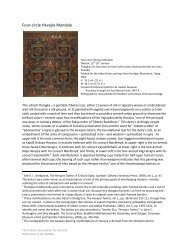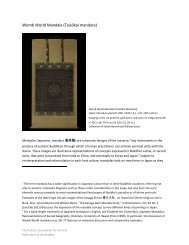Reflections of the Buddha - The Pulitzer Foundation for the Arts
Reflections of the Buddha - The Pulitzer Foundation for the Arts
Reflections of the Buddha - The Pulitzer Foundation for the Arts
Create successful ePaper yourself
Turn your PDF publications into a flip-book with our unique Google optimized e-Paper software.
Ano<strong>the</strong>r work in <strong>the</strong> exhibition, Standing Prince<br />
Shōtoku at Age Two (no. 1), arrived in <strong>the</strong> United States in<br />
1936 with its numerous consecratory and talismanic<br />
items intact and undisturbed in his hollowed-out body.<br />
This wooden statue, created around 1292, depicts <strong>the</strong> imperial<br />
regent <strong>of</strong> Japan, Shōtoku Taishi Nisaizō (574 – 622).<br />
He was one <strong>of</strong> Japan’s earliest followers <strong>of</strong> Buddhism, and<br />
<strong>the</strong> sculpture depicts an apocryphal moment: At age two,<br />
Shōtoku was said to have turned to <strong>the</strong> east, held his<br />
hands toge<strong>the</strong>r in prayer, and recited <strong>the</strong> nembutsu (“Namo<br />
Amida Butsu”), <strong>the</strong> oral invocation <strong>of</strong> <strong>the</strong> <strong>Buddha</strong><br />
Amitābha, <strong>the</strong> <strong>Buddha</strong> <strong>of</strong> Infinite Light. More than seventy<br />
individual items were found inside this sculpture. <strong>The</strong>y<br />
not only help date <strong>the</strong> work but also provide insights into<br />
<strong>the</strong> diversity <strong>of</strong> medieval Japanese Buddhist belief.<br />
<strong>The</strong> items inside Standing Prince Shōtoku include<br />
tiny Buddhist relics made <strong>of</strong> semi-precious stones, a variety<br />
<strong>of</strong> miniature devotional statues, sūtras, a twill-weave<br />
silk bag, and a number <strong>of</strong> Sanskrit mantras (verses or<br />
hymns <strong>of</strong> praise) written on paper (fig. 2). <strong>The</strong>se objects<br />
connect to multiple Buddhist traditions in Japan. Some<br />
items appear to be from <strong>the</strong> Mahāyāna Pure Land tradition<br />
that venerates Amitābha, o<strong>the</strong>rs Zen, which is based<br />
on <strong>the</strong> Chinese Ch’an School that taught powerful meditative<br />
practices to anyone. <strong>The</strong> Vajrayāna schools <strong>of</strong><br />
Tendai and Shingon were also represented. Tendai syn<strong>the</strong>sizes<br />
Ch’an meditation and Tantric practice with a<br />
<strong>for</strong>m <strong>of</strong> Chinese T’ien-t’ai Buddhism, which seeks to<br />
unify different Buddhist schools into “One Vehicle” partially<br />
through <strong>the</strong> teachings <strong>of</strong> <strong>the</strong> Lotus Sūtra. Shingon,<br />
on <strong>the</strong> o<strong>the</strong>r hand, is based on <strong>the</strong> teachings <strong>of</strong> <strong>the</strong><br />
Chinese Chên-yen School that stressed visualizations and<br />
mantras used in Tantric practices and rituals that were<br />
established in Japan by <strong>the</strong> Buddhist monk Kūkai (774 –<br />
835). <strong>The</strong> items from different doctrinal schools inside<br />
Standing Prince Shōtoku reflect <strong>the</strong> complexity <strong>of</strong> <strong>the</strong> diffusion<br />
<strong>of</strong> Buddhism throughout Asia.<br />
Several items inserted into Standing Prince<br />
Shōtoku help scholars associate it with Eison (1201 – 1290),<br />
<strong>the</strong> founder <strong>of</strong> <strong>the</strong> Shingon Risshū sect, and his followers.<br />
11 First is a small sculpture <strong>of</strong> Eison’s personal<br />
protector, <strong>the</strong> ferocious deity Rāgarāja, who is capable <strong>of</strong><br />
“freeing a devotee from lust.” 12 <strong>The</strong>re are also three manuscript<br />
books that present rules <strong>of</strong> monastic behavior and<br />
liturgy, which reflect <strong>the</strong> Shingon Risshū sect’s emphasize<br />
on <strong>the</strong> Vinaya precepts. <strong>The</strong>se were prescribed<br />
Buddhist teachings <strong>of</strong> morality and comportment <strong>for</strong> monastic<br />
orders, institutional rules <strong>for</strong> <strong>the</strong> governance <strong>of</strong><br />
<strong>the</strong> Buddhist community (San� gha), and <strong>the</strong> consequences<br />
<strong>for</strong> breaking <strong>the</strong>se rules. In order to represent <strong>the</strong><br />
Buddhist teachings (Dharma), Eison and his followers<br />
would insert sūtras and mantras written on paper into<br />
hollowed-out figures. As a way to represent his San� gha,<br />
he would install practitioners’ vows. All <strong>the</strong>se types <strong>of</strong><br />
documents were found inside <strong>the</strong> sculpture, but <strong>the</strong>y do<br />
not necessarily confirm all <strong>the</strong> functions <strong>of</strong> <strong>the</strong> work or<br />
<strong>the</strong> identity <strong>of</strong> <strong>the</strong> sect that commissioned it.<br />
<strong>The</strong> invocation <strong>of</strong> <strong>the</strong> <strong>Buddha</strong>, Dharma, and<br />
11<br />
San� gha — known toge<strong>the</strong>r as <strong>the</strong> “Three Jewels” — is<br />
manifested in <strong>the</strong> historical figure <strong>of</strong> Prince Shōtoku himself.<br />
<strong>The</strong> prince supported <strong>the</strong> building <strong>of</strong> seven temples,<br />
issued an imperial decree that urged everyone to accept<br />
<strong>the</strong> Three Jewels as <strong>the</strong> highest refuge <strong>for</strong> all living<br />
beings, and authored eight volumes <strong>of</strong> commentary on<br />
<strong>the</strong> Lotus Sūtra and o<strong>the</strong>r sacred writings. 13 At his death,<br />
Prince Shōtoku is said to have quoted a passage from <strong>the</strong><br />
Dharmapada: “Avoid evil, undertake good, and purify <strong>the</strong><br />
mind.” 14 Through <strong>the</strong>se actions, one attains <strong>the</strong> wisdom<br />
<strong>of</strong> emptiness, which, in turn, allows one to see an inner-<br />
<strong>Buddha</strong> potential within oneself and all o<strong>the</strong>r beings. <strong>The</strong><br />
clerics who likely commissioned Standing Prince Shōtoku<br />
may have used <strong>the</strong> sculpture in various ways: as a consecrated<br />
icon with additional talismanic powers and as a<br />
way to present <strong>the</strong>mselves as authorities <strong>of</strong> Prince<br />
Shōtoku’s teachings.<br />
<strong>The</strong> Buddhist traditions launched by Prince<br />
Shōtoku would wax and wane in popularity and significance<br />
over <strong>the</strong> centuries in Japan. Interest in traditional<br />
<strong>for</strong>ms <strong>of</strong> Buddhism had already started to decrease<br />
during <strong>the</strong> anti-Buddhist persecutions <strong>of</strong> <strong>the</strong> Meiji period<br />
(1868 – 1912). 15 Today, Buddhist practices continue to be a<br />
part <strong>of</strong> important rituals like funerals and seasonal celebrations.<br />
Buddhist concepts and aes<strong>the</strong>tics also continue<br />
to inspire cultural figures in Japan, including <strong>the</strong><br />
<strong>Pulitzer</strong>’s architect, Tadao Andō.<br />
Part II:<br />
Trans<strong>for</strong>mative Functions <strong>of</strong> <strong>the</strong> Building<br />
Even though additional Asian and Western ideas have influenced<br />
Tadao Andō’s designs, <strong>Reflections</strong> <strong>of</strong> <strong>the</strong> <strong>Buddha</strong><br />
aims to emphasize his connection to Buddhism by sparking<br />
new and dynamic relationships through <strong>the</strong> display<br />
<strong>of</strong> Buddhist art in his spaces. <strong>The</strong> lack <strong>of</strong> adornment and<br />
<strong>the</strong> simple geometry and materials <strong>of</strong> Andō’s buildings<br />
may be regarded as characteristics <strong>of</strong> Western<br />
Modernism. Yet Buddhist concepts found in his writings<br />
and interviews <strong>of</strong>fer ano<strong>the</strong>r way to understand his architecture.<br />
<strong>The</strong>y provide an opportunity to experience <strong>the</strong><br />
<strong>Pulitzer</strong> as a “living” environment where <strong>the</strong> visitor, <strong>the</strong><br />
space, and <strong>the</strong> art become <strong>the</strong>mselves through <strong>the</strong>ir interdependence,<br />
a concept central to Buddhism and to <strong>the</strong><br />
selection and display <strong>of</strong> art in this exhibition.<br />
In a recently published interview, Andō spoke<br />
<strong>of</strong> himself as a designer <strong>of</strong> symbolic architecture —<br />
“where we live and die, where we think about life and<br />
death, and <strong>the</strong> world <strong>of</strong> this life and Nirvāna . . . Symbolic<br />
architecture should emerge from <strong>the</strong> struggles with<br />
<strong>the</strong>se human conditions.” 16 In <strong>the</strong> same interview, Andō<br />
also acknowledged that:<br />
God, to <strong>the</strong> Japanese, exists in nature. I do not know whe<strong>the</strong>r this<br />
would be an acceptable view in Christianity or not. In fact, that<br />
god exists in nature means that god exists in one’s mind. Many<br />
people think that god exists outside <strong>of</strong> self. But, a god who exists




